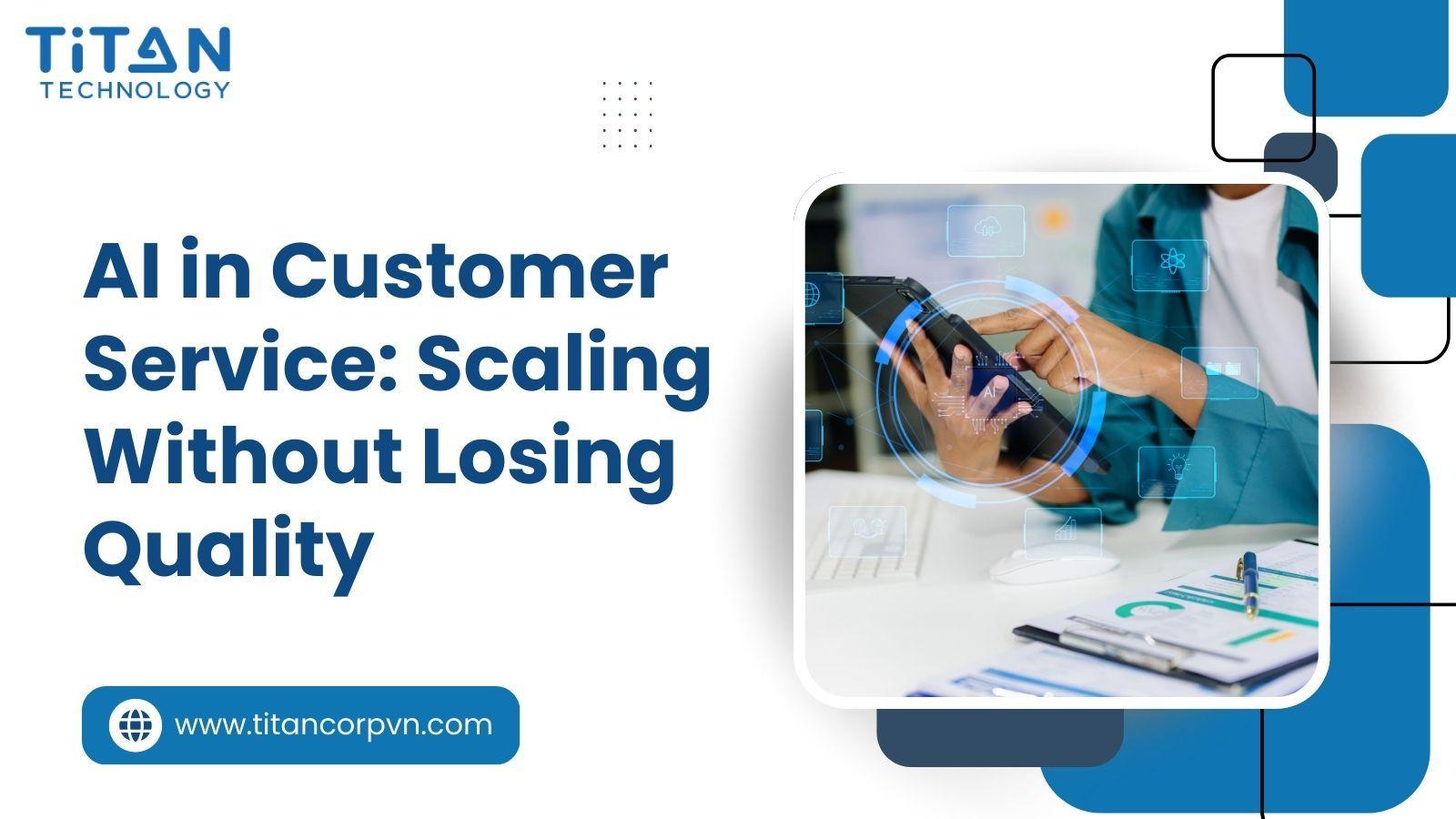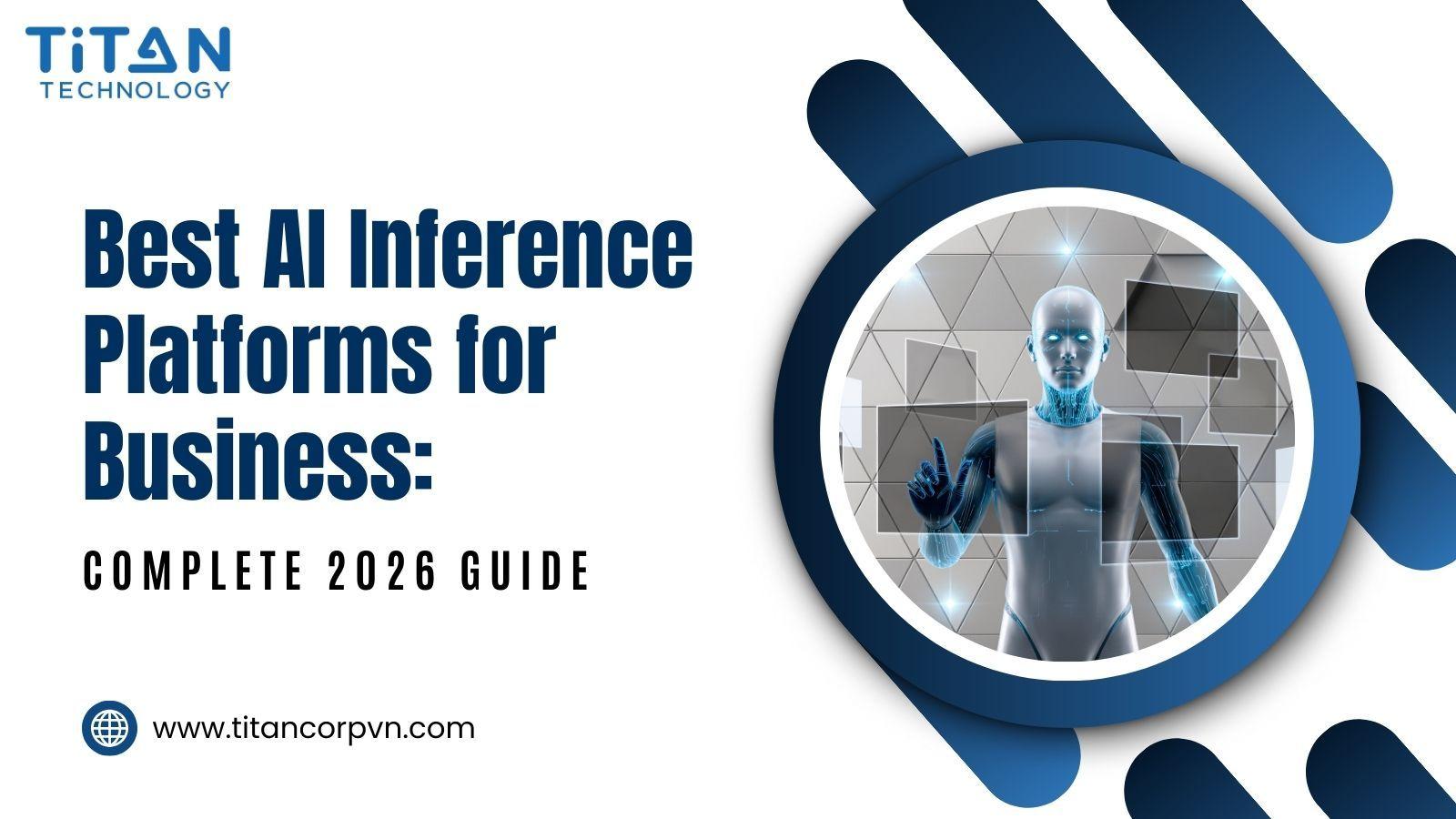Summary
Artificial Intelligence (AI) is no longer science fiction — it’s a practical technology reshaping how people live, work, and innovate.
This guide explains what AI really is, how it learns from data, and how it makes intelligent decisions similar to human reasoning.
Discover the five core stages of AI development — Data, Models, Training, Feedback, Deploymentand how each drives smarter outcomes.
Trace the evolution of AI from early theories in the 1950s to the rise of machine learning, deep learning, and generative AI in the 2020s.
Explore real-world applications across industries including healthcare, finance, manufacturing, logistics, education, and marketing.
Understand the ethical and regulatory challenges shaping AI’s future from bias and transparency to privacy, governance, and sustainability.
Learn why Responsible and Auditable AI will define the next decade, where trust, transparency, and human collaboration drive innovation.
Gain insights into the future of AI (2025–2030) — from agentic intelligence and hybrid human–machine collaboration to sustainable and decentralized AI systems.
Ultimately, AI’s purpose is not to replace people but to amplify human potential, enabling smarter decisions and a more sustainable digital world.
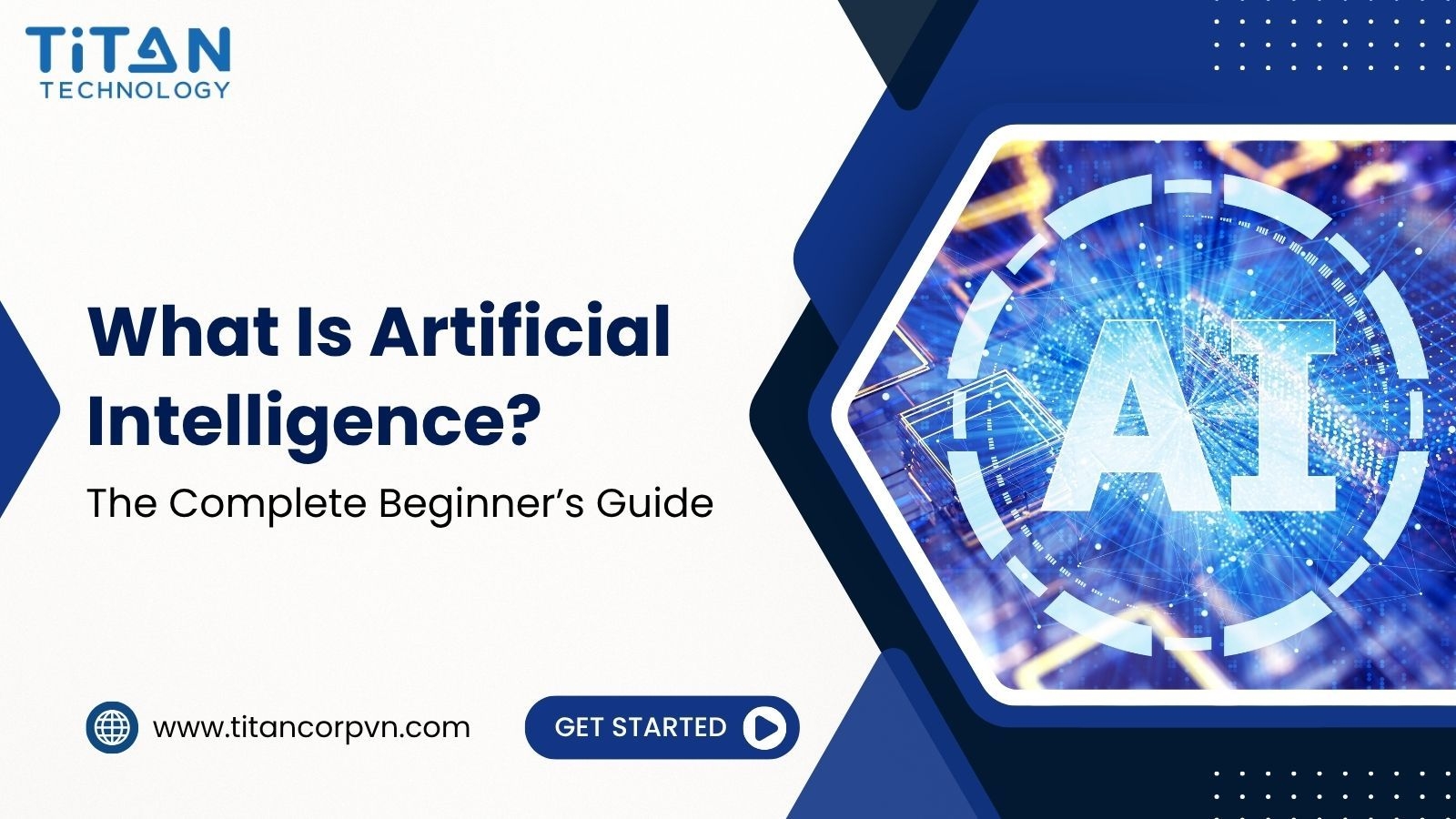
A small retail startup once spent months developing a customer app, only to watch users abandon it after the first login. After integrating an AI-driven recommendation engine, engagement doubled within weeks.
Stories like this are now common. Artificial Intelligence (AI) is quietly transforming how companies operate, from predicting demand and detecting fraud to personalizing healthcare and optimizing logistics. Yet despite its rapid adoption, confusion remains. Many professionals and students still ask: What exactly is Artificial Intelligence, and how does it work?
According to the Stanford Artificial Intelligence Index Report 2025, global AI adoption has reached record levels, reshaping industries and skill requirements worldwide.
This article explains what AI truly means in simple, practical terms. You will learn how it works, where it delivers real value, and how it is shaping the future of business, innovation, and everyday life.
Understanding Artificial Intelligence: The Real Meaning Behind the Term
When most of us hear the phrase Artificial Intelligence (AI), we instantly picture scenes from science fiction: self-aware humanoid robots, machines that surpass human intellect, or dystopian worlds where computers take control. In reality, AI is far less dramatic and far more practical, quietly shaping how we live and work every single day.
What Is AI, Really? Peeling Back the Technical Layers
At its core, Artificial Intelligence is the science of teaching machines to learn from data and make decisions that mirror human reasoning. It is not a mission to replace people but an effort to extend human capability — giving technology the ability to recognize patterns, adapt to new information, and solve problems with intelligent precision.
Think of how you use technology every day:
When Netflix recommends a series that fits your mood.
When your smartphone unlocks by recognizing your face.
When a bank instantly flags a suspicious transaction before you notice.
These are not coincidences, but the result of systems trained on millions of interactions, learning what “normal” looks like and adjusting their responses in real-time.
The New Strategic Engine for Business
In the business world, AI has evolved from an experimental technology into a strategic driver of growth and competitiveness. Executives use it to forecast demand, detect fraud, optimize supply chains, and deliver personalized customer experiences. For startups, it acts as a powerful equalizer, allowing lean teams to achieve insights and efficiency once reserved for large enterprises.
However, AI is not a single invention or a magic formula. It is an ecosystem of disciplines that brings together computer science, mathematics, linguistics, and psychology. Together, these fields create systems capable of understanding, reasoning, and self-improvement.
In essence, AI is not just code; it is a living system of data and logic that continuously evolves. The more data it processes, the more refined its understanding becomes — just as the human brain strengthens its intelligence through experience. When guided by human purpose, AI does not replace human intelligence; it amplifies it, enabling both individuals and organizations to make smarter, faster, and more meaningful decisions.
How Artificial Intelligence Works: From Data to Decisions
Artificial Intelligence may seem complex, but at its heart, it learns and reasons in ways that are surprisingly similar to human thinking. Just as people learn from experience, AI systems learn from data, only at a scale and speed that no human mind can match.
Every intelligent system, from chatbots to self-driving cars, follows the same fundamental learning loop: data, model, training, feedback, and deployment.
1. Data: The Foundation of Learning
Just as humans build understanding through experience, AI begins with data — the digital reflection of human activity. Text, images, audio, and numbers all feed the system’s learning process. Without data, AI has no context, no memory, and no intelligence.
The quality of data determines the quality of the outcome. Clean, diverse, and well-labeled datasets allow AI to detect meaningful patterns, just as doctors rely on accurate medical records to make reliable diagnoses. In business, poor or biased data can lead to wrong predictions, which is why modern organizations invest heavily in data engineering and governance to ensure that their insights rest on a trustworthy foundation.
2. Models: The Brain Behind the Machine
If data represents experience, the model is the brain that makes sense of it. Models are mathematical structures that help machines interpret patterns and reason about the world.
For instance, a fraud detection model in banking learns what a “normal” transaction looks like and flags anomalies that deviate from that pattern. As it processes more transactions, it refines its sense of what is typical, improving accuracy in much the same way human intuition develops through experience.
Modern models range from simple decision trees to sophisticated deep neural networks designed to replicate the layered structure of the human brain.
3. Training: Turning Data into Intelligence
Training is the stage where AI becomes truly intelligent. The system analyzes massive datasets, adjusts its internal parameters, and improves through repeated iterations of trial and error. Much like humans refine their skills through practice and feedback, AI refines its algorithms through training cycles.
The rise of machine learning and deep learning has made training exponentially more powerful. According to the Stanford AI Index Report 2025, global corporate investment in AI reached USD 252.3 billion in 2024, reflecting how companies now treat AI training as essential infrastructure. Models trained on large and domain-specific datasets can now generate new content, make autonomous decisions, and adapt across industries from healthcare to logistics.
4. Feedback: Learning from Mistakes
No AI system is perfect at the start. Like people, it learns by making and correcting mistakes. Feedback acts as the teacher that helps AI improve performance over time.
When a chatbot misunderstands a customer request or an image recognition system misclassifies an object, these errors become lessons that guide the next iteration. Continuous feedback loops refine the model’s accuracy and alignment with real-world expectations. In enterprise applications, feedback often comes from human review, user interactions, or automated monitoring systems that track key metrics such as precision, recall, and latency.
Over time, AI becomes more reliable, explainable, and aligned with business goals, turning every misstep into a measurable improvement.
5. Deployment: Acting on Intelligence
Once trained and validated, AI moves from development into real-world environments where its intelligence creates tangible impact. Deployment integrates AI models into live systems such as financial monitoring platforms, medical diagnostic tools, or industrial automation solutions.
In production, AI continues to learn and adapt as it encounters new data. This continuous learning cycle transforms AI from a static program into a dynamic system capable of evolving alongside the world it serves. Modern MLOps (Machine Learning Operations) frameworks maintain this process through automation, monitoring, and governance, ensuring that AI remains efficient, ethical, and compliant.
The Stanford highlights that today’s models are not only more accurate but also significantly more efficient. Many new architectures require over one hundred times less computing power than those from just a few years ago while maintaining similar precision. This shift is democratizing AI, making advanced models accessible to startups and mid-sized businesses, not only to large technology companies.
The Evolution of Artificial Intelligence: From Early Theory to Everyday Reality
Artificial Intelligence did not appear overnight. Its journey spans more than seven decades, shaped by human imagination, scientific ambition, and breakthroughs that turned what was once theory into one of the most transformative technologies of modern times.
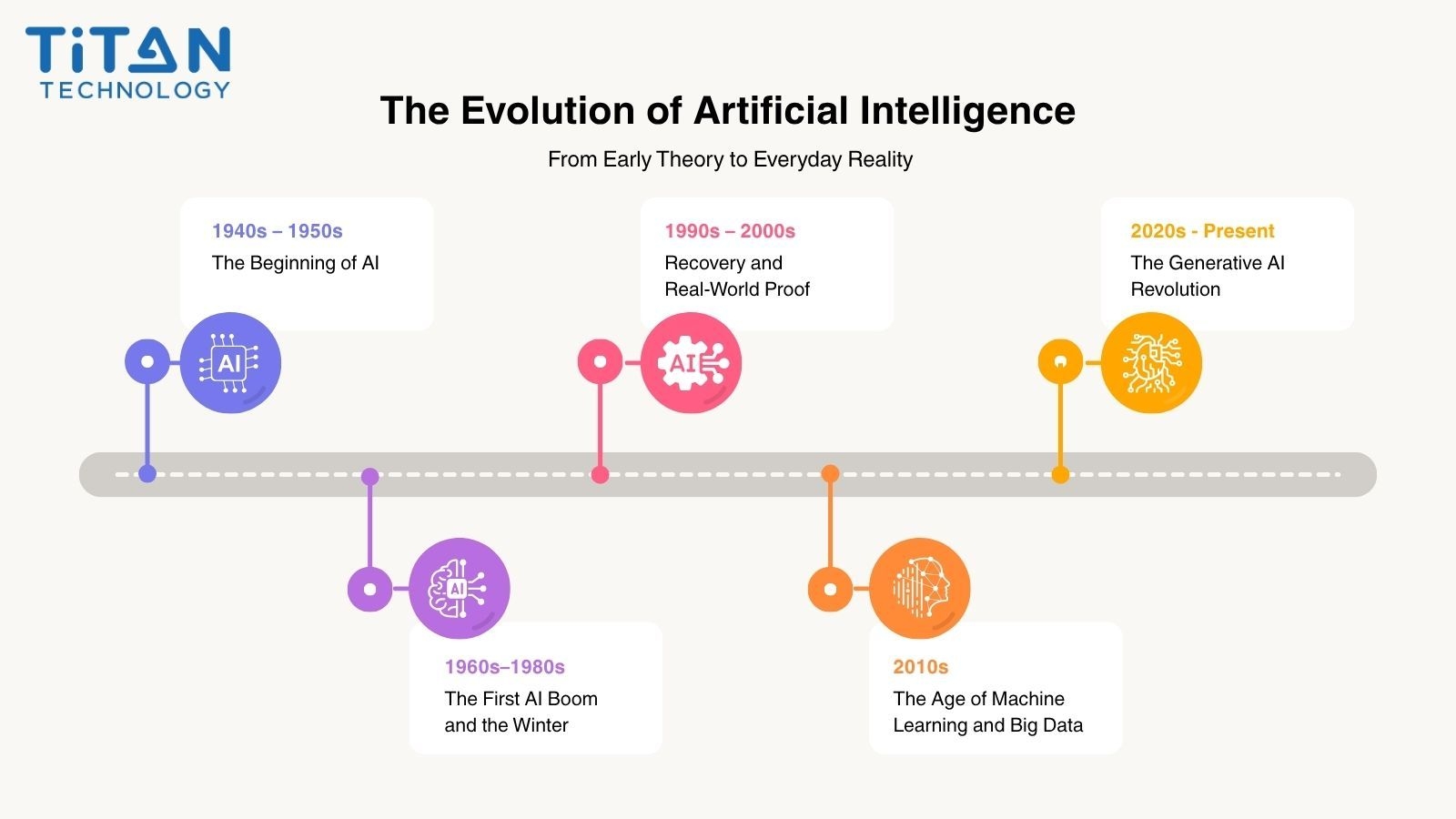
The Birth of an Idea (1940s–1950s)
The concept of intelligent machines began long before computers could understand human language. In 1950, British mathematician Alan Turing posed a question that would define the field for generations: Can machines think? His famous Turing Test sought to measure whether a machine’s behavior could be indistinguishable from a human’s.
A few years later, in 1956, researchers gathered at the Dartmouth Conference, where the term Artificial Intelligence was officially introduced. They believed machines could be taught to reason, learn, and solve problems like humans. This moment marked the birth of a new scientific frontier.
The First AI Boom and the Winter (1960s–1980s)
The early decades of AI were filled with excitement and optimism. Scientists developed expert systems that could make logical decisions in specialized domains such as medicine and engineering. These systems relied on carefully coded rules and demonstrated that machines could, in limited ways, replicate human reasoning.
However, the technology of the time was not ready to meet these grand expectations. Computers lacked the processing power and memory to handle complex reasoning tasks, and funding eventually dried up. By the late 1970s, interest waned, leading to the first AI Winter, a period marked by skepticism and reduced investment.
Recovery and Real-World Proof (1990s–2000s)
AI began to recover as computing power expanded, and the internet connected the world. Larger datasets, faster processors, and improved algorithms made it possible to solve problems that were previously out of reach.
In 1997, IBM’s Deep Blue defeated world chess champion Garry Kasparov, proving that machines could outperform humans in structured strategic thinking. A decade later, IBM’s Watson advanced this progress further by winning the television quiz show Jeopardy!, showcasing the ability to process natural language and extract accurate answers from vast amounts of data.
These milestones marked a turning point. AI had moved beyond theory and entered the realm of practical achievement.
The Age of Machine Learning and Big Data (2010s)
With the rise of big data and cloud computing, a new era of AI began. Machine learning and deep learning techniques allowed systems to recognize patterns, translate speech, and make predictions with unprecedented accuracy.
Technology companies began embedding AI into everyday products: voice assistants, recommendation systems, image recognition, and predictive analytics became part of daily life. At the same time, cloud infrastructure made powerful AI tools accessible to organizations of all sizes, accelerating adoption across industries.
The Generative AI Revolution (2020s)
The 2020s introduced a new chapter in AI history. Generative AI demonstrated that machines could not only analyze data but also create new content. Tools like ChatGPT, Gemini, and DALL·E began producing text, images, and code with human-like fluency, transforming creativity, communication, and productivity.
According to the McKinsey State of AI 2024 report, more than 70 percent of global organizations now use AI in at least one business function, nearly doubling the adoption rate from five years earlier. Global investment in generative AI continues to surge, reflecting its growing role as both a creative and analytical engine for modern enterprises.
This period also brought new challenges and responsibilities. As AI systems became more autonomous and capable, questions around ethics, transparency, and accountability came to the forefront. Businesses and governments worldwide began focusing not only on innovation but also on the responsible governance of AI technologies.
Everyday Reality: Intelligence Everywhere
Today, AI has moved beyond the research lab into the heart of everyday life. It filters spam from emails, predicts maintenance needs in factories, assists doctors in identifying diseases, and powers tools that understand speech and vision.
The line between using technology and working with intelligence is increasingly blurred. What once seemed like science fiction has become an invisible infrastructure that supports decisions, powers automation, and personalizes experiences across industries.
Artificial Intelligence has evolved from a question: Can machines think? —into an answer that reshapes how humanity innovates, learns, and connects. Its evolution reflects not only advances in algorithms and computing but also the ongoing human drive to create technology that enhances understanding and expands possibility.
Key Applications of Artificial Intelligence in 2025 and Beyond
Artificial Intelligence has evolved from a research concept into a practical force that drives innovation and efficiency across industries. In 2025, its influence extends far beyond automation, reshaping how businesses make decisions, serve customers, and create value in an increasingly data-driven world. As organizations mature in their digital transformation journeys, AI is shifting from experimental projects to enterprise-wide strategies that define long-term competitiveness.
Healthcare: Smarter Diagnostics and Predictive Care
AI continues to transform healthcare by enhancing precision, reducing diagnostic errors, and accelerating the discovery of new treatments. Machine learning models can now detect diseases such as cancer and cardiovascular conditions at earlier stages, enabling physicians to intervene sooner and improve patient outcomes. Hospitals are also using predictive analytics to identify patients at risk of readmission, allowing for better resource planning and quality of care.
Recent peer-reviewed studies show that AI-assisted diagnostic tools improve accuracy and shorten evaluation time in radiology and pathology. Pharmaceutical companies are applying generative AI to simulate molecular interactions, which can reduce the drug development timeline from years to months. The result is faster innovation, lower costs, and more personalized care.
Finance: Risk Management and Fraud Detection
In the financial sector, AI is redefining how institutions manage risk and maintain trust. Banks and fintech firms employ machine learning models to detect fraudulent activity in real time, scanning millions of transactions and flagging anomalies that human analysts might overlook. Predictive credit scoring systems enhance transparency and reduce bias in lending decisions, while AI chatbots deliver faster, more consistent customer service.
According to the McKinsey Global AI Survey 2025, financial institutions that integrate AI into core operations report up to 30 percent improvement in fraud detection accuracy and 20 percent faster compliance checks. As financial ecosystems become more complex, AI is shifting from reactive protection to proactive governance — helping organizations anticipate risks before they escalate.
Manufacturing: Intelligent Automation and Predictive Maintenance
In manufacturing, AI is the foundation of Industry 4.0. By combining machine learning with the Internet of Things (IoT), factories are becoming intelligent, adaptive, and self-optimizing. Predictive maintenance enables machines to detect potential failures before they happen, reducing downtime and saving millions in operational losses.
Computer vision technologies are used for real-time quality control, ensuring that products meet strict standards without slowing down production. Robots powered by AI now handle repetitive or hazardous tasks with precision and safety, freeing workers to focus on creative and strategic functions. Over the next decade, AI-driven optimization will also play a central role in sustainability, helping manufacturers minimize waste and energy consumption while maintaining productivity.
Logistics and Supply Chain: Real-Time Optimization
Supply chains are no longer static networks; they are dynamic ecosystems that require constant visibility and adaptability. AI provides the intelligence layer that keeps them running efficiently. Through predictive demand forecasting, real-time route optimization, and inventory automation, AI helps companies respond faster to market shifts and disruptions.
In logistics, AI-powered systems are managing fleets, predicting delivery delays, and even guiding autonomous warehouse vehicles. This level of coordination reduces emissions, cuts costs, and improves delivery reliability. As a result, businesses are entering an era of adaptive supply chains that learn and optimize continuously, strengthening resilience in a volatile global market.
Education and Workforce Training: Personalized and Lifelong Learning
AI is redefining how people learn by turning education into a more adaptive, learner-centered experience. Intelligent tutoring systems analyze performance data and tailor content in real time to each student’s strengths and weaknesses. In higher education and corporate training, AI tools assess skill gaps and recommend customized learning paths to prepare individuals for emerging roles in the digital economy.
Generative AI is also becoming a personal learning companion, assisting with content creation, translation, and interactive problem-solving. As education becomes more accessible and data-driven, the focus is shifting from standardized teaching to continuous learning that evolves alongside technology and industry needs.
Marketing and Customer Experience: Relevance at Scale
AI enables brands to understand and anticipate customer needs with unprecedented accuracy. By combining behavioral analytics, sentiment detection, and predictive modeling, marketers can deliver hyper-personalized experiences at scale.
Recommendation engines and generative AI tools are transforming how campaigns are designed, from copywriting to visual creation, ensuring that every interaction feels timely and relevant.
As AI systems gain access to richer data, the emphasis is shifting from short-term conversion metrics to building authentic, trust-based relationships. In this new landscape, responsible data usage and transparent AI models are becoming key differentiators for brands that want to sustain loyalty over time.
Insight: From Automation to Intelligence
Across all industries, the most profound impact of AI lies not in replacing human effort but in amplifying human potential. AI is evolving from a tool for automation into a strategic layer of intelligence that enhances decision-making, accelerates innovation, and strengthens competitiveness.
As we move further into 2026 and beyond, the question is no longer what AI can do but how responsibly it can be governed. Organizations that combine innovation with transparency and ethics will lead the next chapter of intelligent transformation, where technology serves not just efficiency but also trust and human progress.
Challenges and Ethical Considerations in Artificial Intelligence
As Artificial Intelligence becomes deeply integrated into business and society, its potential benefits are matched by equally significant challenges. The next phase of AI advancement will not only be about technological capability but also about moral and operational responsibility. Building trust in AI now depends on how effectively organizations address issues such as bias, transparency, security, and sustainability.
Bias and Fairness
AI systems learn from data, and that data reflects human history with all its imperfections. If training data contains social, economic, or cultural bias, the system may unintentionally reinforce inequality. For example, recruitment algorithms trained on historical hiring data have been shown to favor certain demographics over others, perpetuating past biases rather than correcting them.
Ensuring fairness requires more than diverse datasets. It demands deliberate design choices, continuous auditing, and inclusive governance. In recent years, organizations have begun adopting frameworks for ethical AI modeling that prioritize explainability, diverse sampling, and bias testing. These measures are helping AI systems make decisions that are both accurate and equitable, reinforcing the principle that technology should serve everyone, not just a few.
Transparency and Explainability
One of the greatest challenges in AI adoption is the “black box” problem — systems that produce accurate outcomes without revealing how those outcomes are derived. As AI influences decisions in healthcare, finance, and governance, the need for explainability is becoming a moral and legal imperative.
Explainable AI (XAI) aims to bridge this gap by providing insights into how algorithms reach their conclusions. By making the reasoning process visible, XAI helps users understand the logic behind recommendations, builds confidence in automated systems, and enables regulators to assess compliance. In the coming years, transparency will not just enhance trust; it will determine whether AI solutions are accepted or rejected by the public.
Data Privacy and Security
AI thrives on data, yet its dependence on vast and sensitive datasets exposes it to unprecedented privacy and security risks. From healthcare records to financial transactions, data fuels the algorithms that drive insight and automation. However, without proper controls, it also opens doors to breaches, misuse, and loss of trust.
Governments and organizations are responding by strengthening privacy frameworks. Regulations such as the EU General Data Protection Regulation (GDPR) and the upcoming EU AI Act are setting clearer standards for data collection, consent, and model accountability. In Asia and the Middle East, new national frameworks are also emerging, aiming to balance innovation with privacy protection. The future of AI will depend on how well companies can maintain data integrity while delivering personalized, data-driven experiences.
Regulation and Global Governance
The coming decade will define the global rules for responsible AI. In 2025, the European Union’s AI Act will take full effect, introducing a risk-based framework that classifies AI systems according to their societal impact, from minimal to high risk. Meanwhile, the NIST AI Risk Management Framework (RMF) in the United States and similar initiatives in the UAE, Singapore, and Japan reflect a worldwide movement toward harmonized governance.
Regulation is no longer viewed as a limitation but as an enabler of trust. Clear standards create a level playing field where innovation and safety can coexist. Companies that proactively align with these frameworks will not only ensure compliance but also gain a strategic advantage by building technology that customers and regulators alike can trust.
Workforce Transition and Skills Evolution
AI-driven automation is reshaping the global labor market, eliminating some tasks while creating entirely new roles that blend technical and human skills. By 2030, the World Economic Forum estimates that nearly half of all employees will require significant reskilling or upskilling to remain relevant.
Forward-thinking organizations are responding with AI literacy programs and adaptive learning initiatives that help workers evolve alongside technology. The future workforce will increasingly focus on creativity, critical thinking, and collaboration — skills that complement rather than compete with AI. The companies that succeed will be those that treat talent development not as a cost, but as a core strategy for resilience.
Sustainability and Environmental Impact
Behind every AI model lies immense computational power, and with it, significant energy consumption. Training large-scale models can generate a substantial carbon footprint, posing new questions about the environmental cost of digital progress.
Research into green AI is gaining momentum, focusing on energy-efficient algorithms, optimized model architectures, and renewable-powered data centers. Organizations are also measuring the environmental impact of their AI initiatives as part of broader sustainability goals. The next generation of AI leadership will be defined not only by accuracy or speed but by a commitment to innovation that respects the planet’s limits.
Insight: From Ethical Awareness to Strategic Accountability
The real challenge of Artificial Intelligence in 2025 and beyond is not technical mastery but moral maturity. As AI becomes the invisible infrastructure of global progress, ethics must evolve from a compliance requirement to a strategic priority. Frameworks such as the EU AI Act and NIST RMF offer foundations for responsible practice, but real accountability comes from leadership culture — from executives who choose transparency, fairness, and human-centered design as guiding principles.
For forward-looking enterprises, responsible AI is not a constraint but a competitive advantage. Trustworthy systems inspire confidence, attract investment, and sustain long-term value. By aligning innovation with integrity, organizations can ensure that Artificial Intelligence strengthens not only business performance but also the societies and environments it touches.
The Future Outlook of Artificial Intelligence (2025–2030)
Artificial Intelligence is entering its most transformative decade. Between 2025 and 2030, it will evolve from a visible technology into an invisible infrastructure that quietly powers economies, reshapes industries, and influences how humans work, learn, and connect. The question ahead is no longer about what AI can do, but how responsibly and sustainably it can advance.
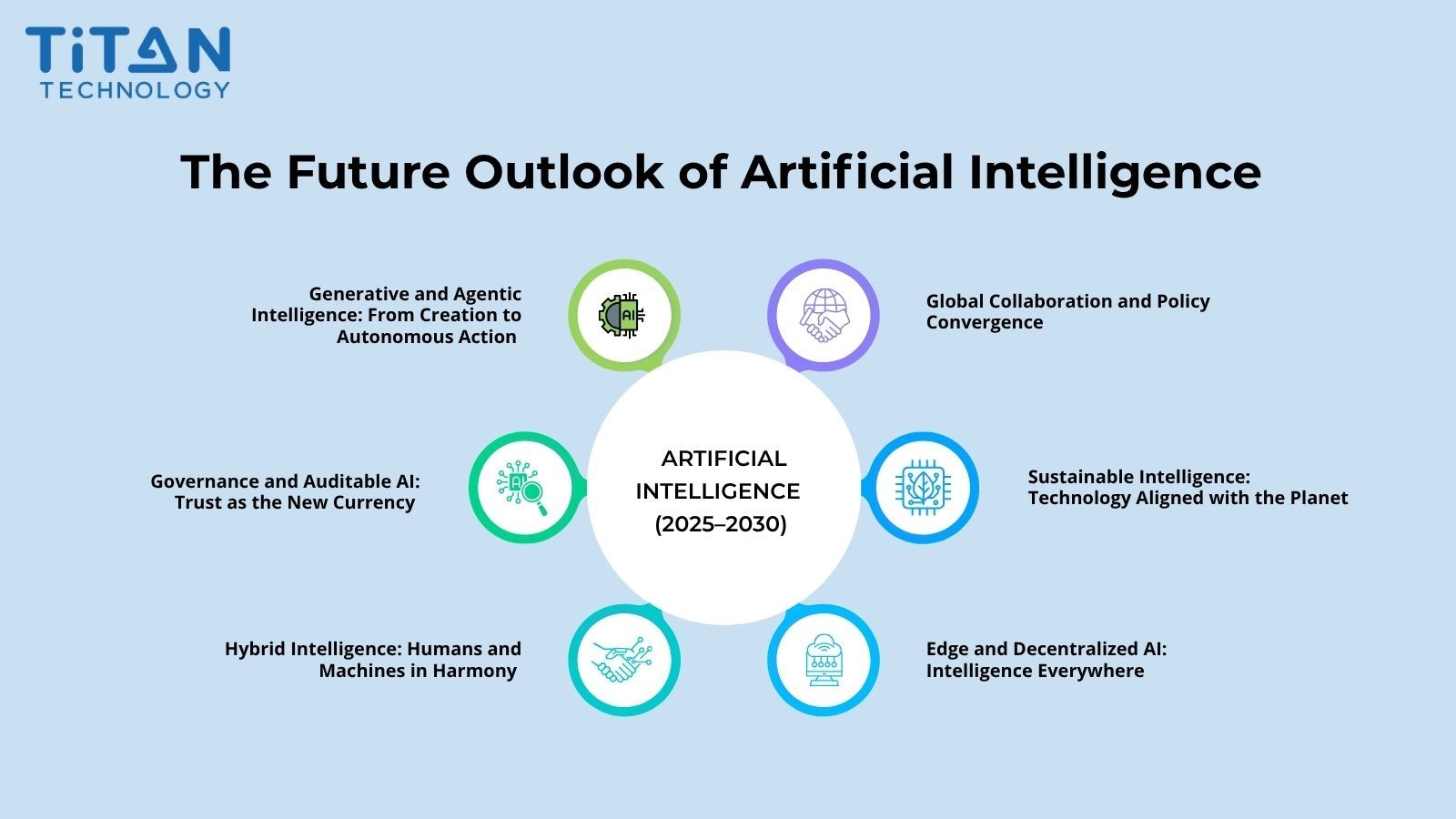
Generative and Agentic Intelligence: From Creation to Autonomous Action
Generative AI has already proven its ability to create text, images, and code with human-like fluency. The next frontier is agentic intelligence — AI systems that not only generate content but also take autonomous action. These intelligent agents can plan, reason, and execute complex tasks across connected environments.
In the enterprise landscape, this evolution means AI will move from assisting workflows to orchestrating them. Future systems will monitor operations in real time, make recommendations, and even act on behalf of humans when precision and speed are critical. Companies that master the balance between autonomy and oversight will gain a decisive competitive edge, turning intelligence into a true strategic partner rather than a background tool.
Governance and Auditable AI: Trust as the New Currency
As AI becomes deeply embedded in decisions that affect lives, accountability will emerge as the defining measure of trust. The next five years will see the rise of auditable AI, systems designed to explain their reasoning, trace their data sources, and justify their outputs in ways that regulators and non-technical users can understand.
Much like financial audits, these mechanisms will ensure that AI decisions are transparent and traceable. Organizations that adopt verifiable AI governance will earn public trust, attract ethical investors, and strengthen resilience against regulatory risk. In this new era, trust will be the most valuable currency of technological progress.
Hybrid Intelligence: Humans and Machines in Harmony
The future of work will not be defined by competition between humans and machines but by collaboration. Hybrid intelligence merges human creativity, empathy, and ethical judgment with the analytical precision and scalability of AI.
Decision-making in boardrooms, factories, and research labs will increasingly be driven by this partnership. Humans will provide context and conscience, while AI delivers insight and speed. Together, they will form decision ecosystems capable of solving complex global challenges — from sustainability to healthcare innovation.
Edge and Decentralized AI: Intelligence Everywhere
By 2030, Artificial Intelligence will no longer rely solely on massive, centralized data centers. Edge AI — intelligence that operates directly on devices, sensors, and local systems — will enable real-time decision-making exactly where data is created.
This shift will improve privacy, reduce latency, and unlock new capabilities in areas such as smart manufacturing, logistics, and personalized healthcare. Advances in connectivity and quantum computing will further amplify this decentralization, allowing organizations to deploy intelligence at the speed of business. The result will be a world where AI is everywhere, yet unobtrusive — seamlessly embedded in the systems we depend on every day.
Sustainable Intelligence: Technology Aligned with the Planet
The environmental cost of AI has become impossible to ignore. As models grow larger and more complex, they consume immense computational power and energy. The next era of innovation will be defined by sustainable intelligence, emphasizing energy-efficient architectures, renewable-powered data centers, and algorithmic optimization.
Companies are already measuring the carbon footprint of their AI operations and exploring “green AI” approaches that minimize waste while maintaining performance. In the coming years, leadership in AI will not only be about capability but also about conscience. The organizations that innovate responsibly will shape a future where progress and sustainability advance together.
Global Collaboration and Policy Convergence
Artificial Intelligence is now a shared global infrastructure that transcends borders. The path forward will depend on collaboration among governments, corporations, and academia to create harmonized standards for safety, fairness, and transparency.
Regions such as the European Union, North America, and Asia are already taking steps toward policy alignment. The most successful organizations will be those that embrace this convergence, adopting flexible compliance models that respect global ethics while maintaining innovation speed. Governance will no longer be viewed as bureaucracy but as the backbone of long-term digital trust.
Insight: The Decade of Responsible Intelligence
The coming decade will not be defined by how powerful Artificial Intelligence becomes, but by how wisely humanity chooses to use it. The measure of progress will shift from capability to responsibility.
The organizations that thrive will be those that embed ethics, sustainability, and human values into every stage of AI design and deployment. This is the age of Responsible Intelligence — a time when innovation must serve not only business growth but also social trust and planetary balance.
For visionary enterprises, this is not a constraint but an opportunity. By combining innovation with integrity, companies can lead a global movement where technology strengthens human potential and builds a smarter, safer, and more equitable world.
Conclusion: Shaping a Future of Responsible Intelligence
Artificial Intelligence is no longer just a technology; it has become part of how we live, decide, and dream. From automating tasks to inspiring creativity, AI now touches every dimension of modern life. Yet the true measure of progress lies not in what machines can do, but in how wisely people choose to use them.
The next chapter of AI will be written by humans — by those who guide intelligence with empathy, fairness, and vision. Trust and transparency will define the future more than speed or scale ever could.
At Titan Technology Corporation, we believe intelligence should always serve humanity. When ethics and sustainability guide innovation, technology becomes more than a tool for efficiency; it becomes a partner in building a smarter, safer, and more compassionate world.


